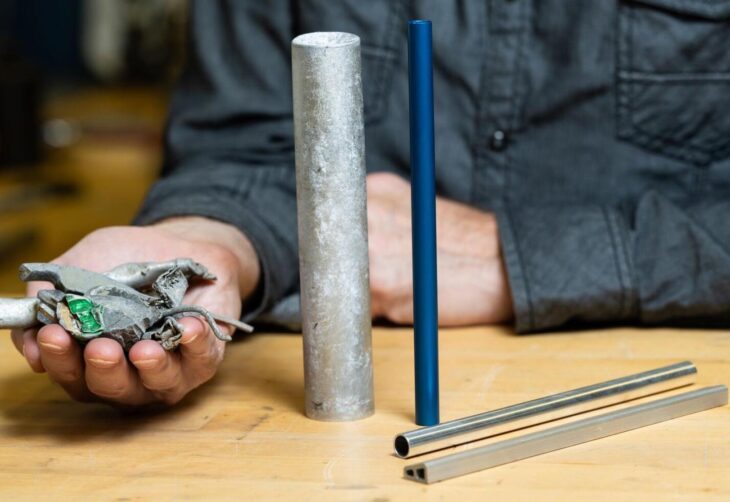Atomic13, a startup launched by Eric Donsky, signed an exclusive agreement with the U.S. Department of Energy’s Pacific Northwest National Laboratory (PNNL) to commercialize the patented Shear Assisted Processing and Extrusion Process (ShAPE™) technology, which can transform 100% post-consumer scrap aluminum into high quality extrusions. The new company aims to create a range of custom profiles in 6061 and 6063 alloys for the building and consumer products markets.
“The ShAPE technology is an amazing opportunity for U.S. manufacturing and the build-out of our critical infrastructure,” said Eric Donsky founder of Atomic13. “We believe there is tremendous environmental and commercial value to building circularity in the aluminum extrusion industry while helping the building and construction industry significantly reduce the embodied carbon of their products.”
PNNL’s patented ShAPE technology uses a rotating ram to directly extruded aluminum feedstock into extrusions. A container holding the scrap is pressed against the an extrusion die with the rotating head, which creates friction that heats up and softens the material enough to be extruded through the rotating die. This process combines and rotates the materials, forming the extrusion profile. Because the technology does not require preheating, external heating during extrusion, or homogenization, it saves energy over conventional extrusion.
“The ShAPE manufacturing process conserves energy and eliminates greenhouse gas emissions on several fronts,” said Scott Whalen chief scientist at PNNL, who led this research. “First, we avoid the need to add primary aluminum. Then, we eliminate the need for what is called homogenization of the billet material, a 6- to 24-hour heat treatment near 500°C prior to extrusion.”
The technology also allows for the removal of primary aluminum, which (depending on its source) can have a high carbon footprint. Instead, the process also allows for the utilization of 100% aluminum scrap, including low-grade scrap, such as Twitch (a shredded post-consumer aluminum scrap mix with a maximum of 1% iron, 1% zinc and 1% magnesium).
“Creating a circular market that provides a value proposition for this twitch scrap opens up the possibility for new industrial uses in the building industry, among sporting goods manufacturers, auto parts, and framing for emerging industries such as solar panel manufacturing,” said Donsky
Aluminum extrusions are a mainstay of the building industry. The ShAPE process further opens up the potential to utilize scrap in construction due to its deformation process, which creates high shear forces that pulverize impurities in the scrap aluminum into tiny particles and uniformly disperse them within the aluminum microstructure. This dispersion eliminates, for example, microscopic iron clumps that can generate microfractures in recycled aluminum products manufactured using conventional methods. ShAPE aluminum extrusion offers massive energy savings by eliminating the need to dilute impurities found in recycled aluminum with 25–40% newly mined aluminum before processing.
The PNNL team performed rigorous testing, evaluating the mechanical properties of rods, tubes and irregular hollow, multichannel trapezoids under mechanical stress. The team tested 540 unique conditions products, made from post-consumer scrap briquettes, some with high iron content (0.2–0.34% iron). All of the products performed at or above ASTM International standards for yield strength and ultimate tensile strength.
“With approximately 55% of the global aluminum extrusion market servicing the building and construction industry, the evolution of ShAPE to include aluminum recycling for building structures is an enormous opportunity for decarbonizing the built environment,” noted Whalen. “We are finding that the unique microstructures within the metal are more tolerant to impurities than previously thought. This enables us to reach even deeper into the aluminum scrap market while maintaining material performance.”
Atomic13 is currently in the design phase of its first commercial manufacturing line with a leading equipment company in the extrusion industry and is also evaluating site locations in the Midwest and Southeast. The company is in discussions with builders and construction companies interested in sustainability and the decarbonization of building materials and plans to accept orders by early 2025.
“ShAPE technology enables companies like Atomic13 to produce aluminum extrusions made from 100% post-consumer scrap with 90% lower carbon,” said Donsky. “At the same time, the low feedstock costs result in lower costs for consumers. We look forward to continuing to work with PNNL engineers to advance this promising technology.”

